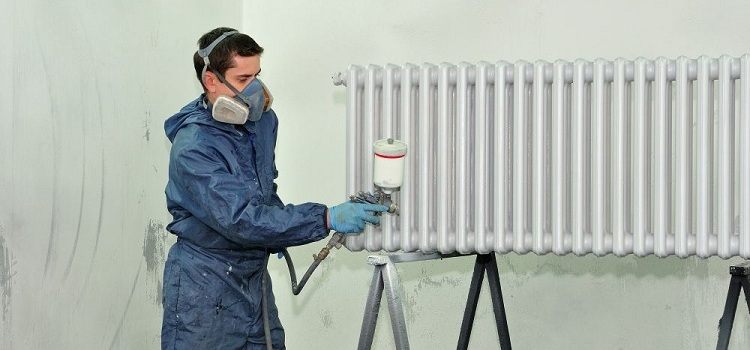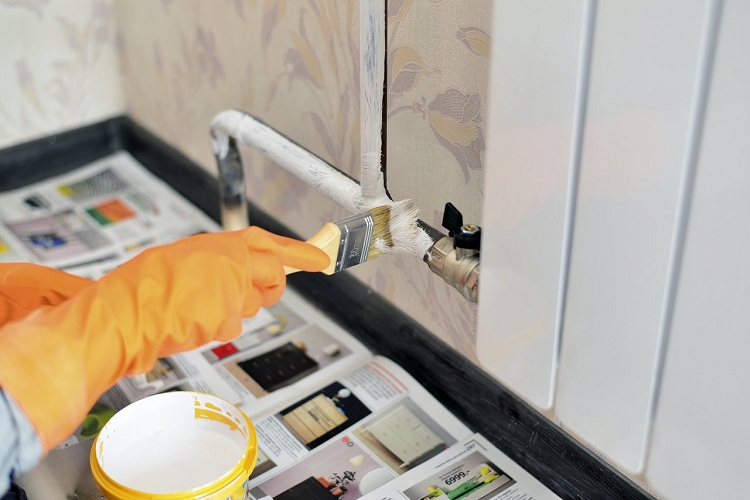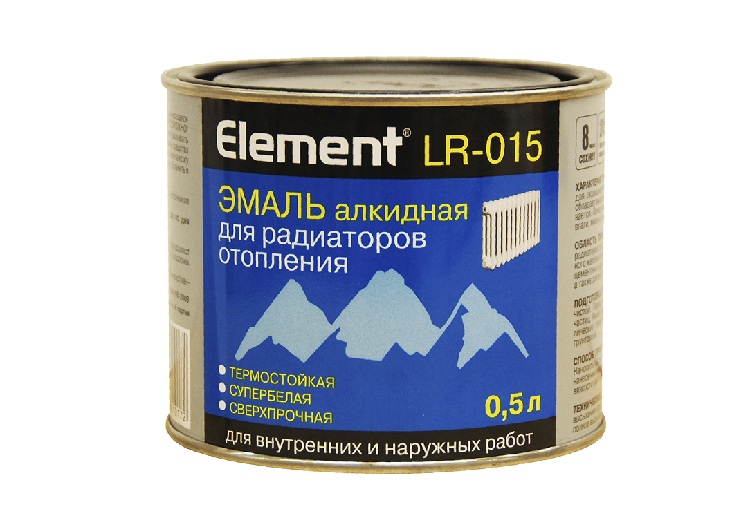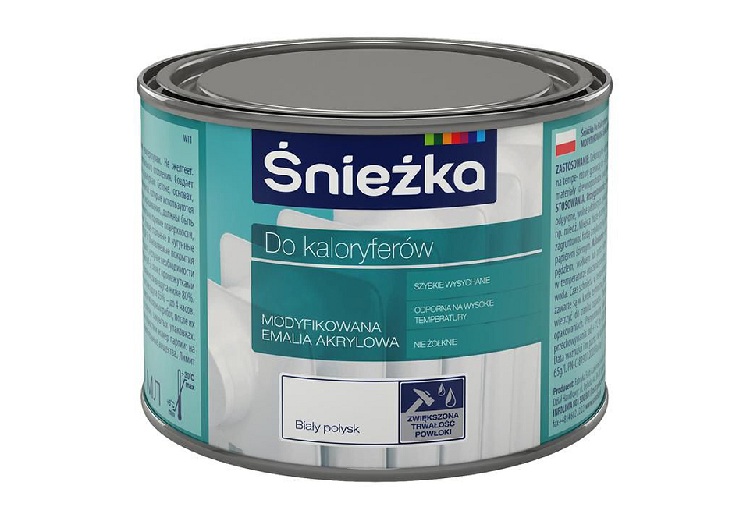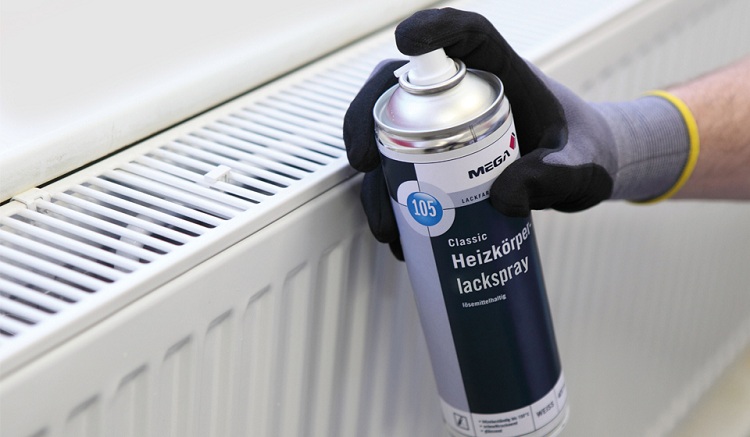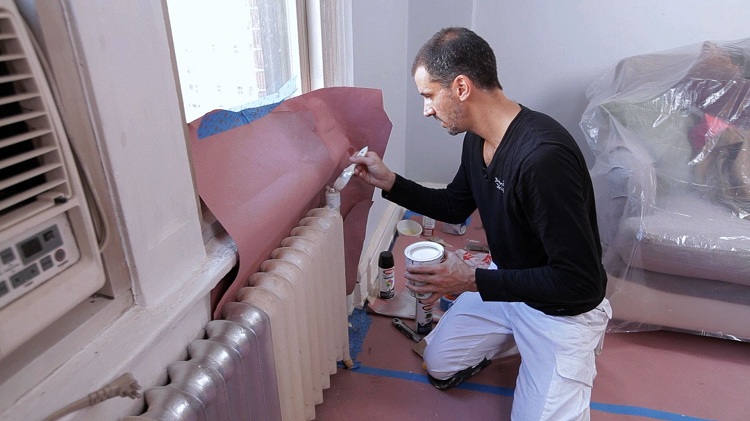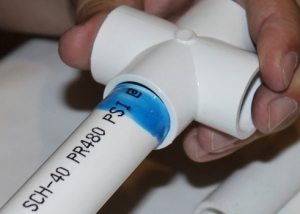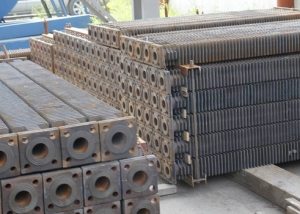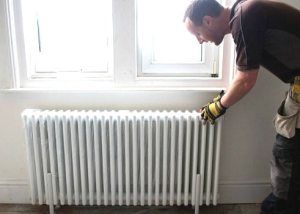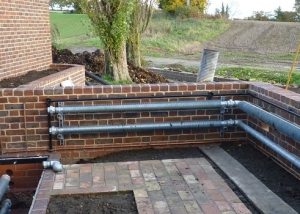Painting radiators allows you to give them a presentable appearance, as well as protect them from the harmful effects of corrosion. Among other things, there are many colors and shades that allow you to paint the radiator so that it is combined with a specific interior. In order to select the necessary paint for the battery, it is necessary to study the varieties of this building material.
Content
What properties should a good paint for radiators have?
Paints that are used to paint heating radiators have some differences from conventional paints. Therefore, in order to choose a good product, it is necessary to study the main characteristics of these compounds:
- First of all, paint for radiators should be environmentally friendly. In no case should it emit toxic substances that can harm the health of residents. When choosing a paint, it is recommended to carefully study its composition - it must comply with the necessary norms and standards;
Important! Domestic manufacturers are regulated by GOST, and foreign brands must comply with European standards. If the manufacturer on the packaging does not refer to the necessary standards established by the state, but to any other conditions or sources, then this may mean that you have a low-quality product. The purchase of such a tool is not recommended.
- the temperature resistance of the composition to be used for painting the heating radiator should not be lower than 70 ° C. Otherwise, during operation, the color coating may begin to peel or turn yellow. It is worth noting that 70 ° C is the minimum acceptable indicator for such a paint. Therefore, it is better to choose a material whose thermal stability index is even higher.
- It is recommended to purchase quick-drying paints, as this property will significantly accelerate the process of painting the radiator. This factor is not mandatory, however, it is better to choose such formulations.
- such paints must necessarily have anti-corrosion properties to give the radiator additional resistance to external aggressive influences.
- some varieties of paints when applied emit a pungent odor that is released until the composition hardens. Such compositions are recommended only for well-ventilated rooms.
- an important property that the composition for painting heating radiators should have is moisture resistance. This quality is necessary in order to be able to carry out wet cleaning using detergents.
- in addition, such paints must have a high coefficient of thermal conductivity, so as not to interfere with the heat transfer of the heating equipment.
Types of paints
The compositions that are used for painting heating radiators are produced in different types and are used for coatings of different metals.Some of them are used only for external coating, and some are used only for internal.
There are many features and individual properties that various paints possess. Many people wonder: what paint to paint the radiator? You can answer this question by studying the main varieties of coloring compounds. All heat-resistant compositions that are used for radiators can be classified into several main types:
- alkyd;
- acrylic;
- powder;
- oil.
A high-quality composition should have good physical and technical characteristics and maintain a normal appearance for several years. In addition, it is desirable to acquire a coloring substance that is odorless. Paint color should not change over time.
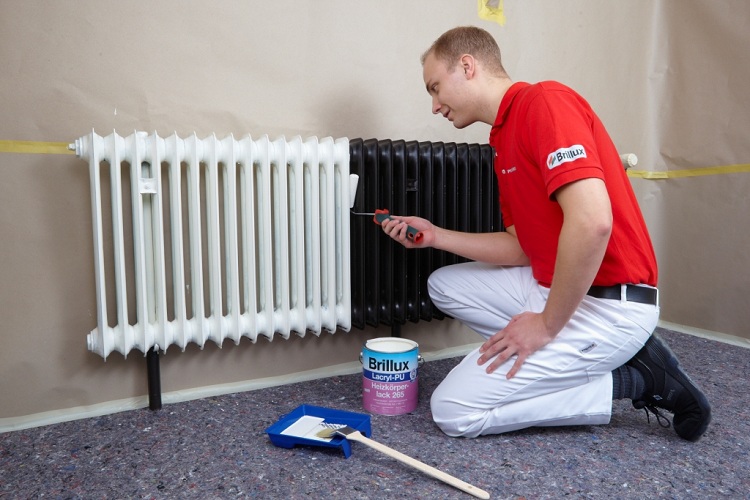
From the entire range of coloring agents, it is better to choose those that are specifically designed for painting batteries
Not all compositions correspond to all of the above requirements, however, if you study the characteristics of paints and be careful, you can purchase a quality product with a long service life.
Alkyd enamel
This type of paint forms a shiny film on the painted surface, which is characterized by high strength. With proper preparation of the surface of the radiator, the operational life of alkyd enamel can last up to 4 years. Such enamels are produced on different bases, so their characteristics differ:
Organic solvent based alkyd enamel. Such compositions have a characteristic, pungent odor and have a fairly wide range of uses. For painting heating radiators, it is necessary to choose enamel based on organic solvents, which is able to withstand temperatures not lower than +70 ° C. The base color of this enamel is white. To obtain the desired color, the necessary coloring pigment is mixed into the base.
Water acrylic alkyd enamel. The main advantage of this type of enamel is the almost complete absence of an unpleasant odor. When buying such a paint, it is recommended to pay attention to the area of use, since many representatives of this group are not suitable for painting metal radiators. In addition, it is worth remembering about operating temperature.
Advice! When choosing white enamel, experts recommend paying attention to its composition - chalk should be absent in the description. This is due to the fact that such a pigment quickly deteriorates and turns yellow when heated, so it is not suitable for painting heating radiators.
Titanium white is added to quality formulations. Such compositions are reliable, but their cost is twice as high as low-quality products.
Organosilicon alkyd enamel. Enamel on this basis is incredibly reliable and is used for surfaces with temperatures up to 600 ° C. With a composition with such characteristics, it is possible to paint not only heating radiators and pipes, but even stoves.
In addition, among the alkyd enamels there is an interesting representative - hammer. Such paint contains special pigments, due to which various visual effects are created. The surface, after painting with such enamel, looks as if beaten with a hammer (therefore, this name). Hammer enamel allows you to mask the defects of the painted surface, which is very convenient.
Acrylic enamel
Such paint is produced on a water basis with the addition of polyacrylates. These substances are film-forming components. If you need a paint for odorless heating radiators, then acrylic enamel is the best choice. Such compounds do not emit harsh aromas, therefore they are recommended for use in residential premises.
Such enamels are used for various purposes. Acrylic paint for radiators and heating pipes must also have good heat resistance and withstand temperatures not lower than +70 ° C.
The main advantage of such enamels is that they are diluted with ordinary water. After solidification, they do not crack, do not wear out and have good reliability in general. In addition, acrylic enamel is very easy to wash. Typically, such enamels may have a semi-gloss or matte finish.
However, before applying such paint, you must first carefully prepare the surface of the radiator. First, rust is removed, after which a special converter must be applied to the surface. Then the surface is degreased and primed. Only after all these manipulations can you start painting.
Powder paint
Such paints are considered the most resistant to mechanical damage and have the longest service life. However, for their application requires some preparation. Also needed is a powder spray gun, a low voltage current source and surface heating.
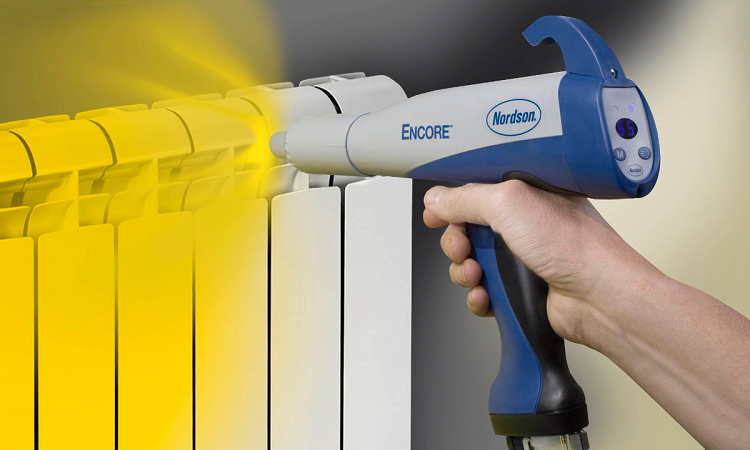
Powder painting is carried out using a special technology and it is quite difficult to do such work at home.
When using powder, it is necessary to ensure uniformity of its application. This goal is achieved by giving the powder a positive charge. The surface of the radiator, in turn, must have a negative charge. Next, it is necessary to heat the paint - it polymerizes and as a result we get a strong, uniform film.
For such paints, there are different polymerization temperatures - from +200 to +350 ° C. Due to the need to heat the radiator to high temperatures, such paints are practically not used at home. To heat the working surface, a special camera is needed. If you want to use just such a paint for your radiator, you can try contacting the nearest service station - cars are painted using the same technology.
Oil paints
Previously, this type of paint was the most common and most of the old batteries and pipes were painted with oil formulations. However, today their use is not relevant, as they have a lot of disadvantages.
The disadvantages of oil compositions include:
- strong unpleasant odor;
- over time, such a paint changes color and cracks.
Repeatedly staining an old battery that was previously painted with oil paint may cause some difficulties. This is due to the fact that the surface after oil paint is usually cracked and applying a special high-quality composition will still not help to improve the appearance of the heater.
Spray paint
It is worth mentioning the painting method, which has become quite popular in recent years - the use of spray cans. Such cans are quite convenient to use and do not require any special building skills. Similar paints are available for heating appliances. The choice of spray can with a coloring composition for the radiator follows the same principle - it is necessary to pay attention to the operating temperature.
For some people, the process of applying this composition is accompanied with certain difficulties. However, in reality everything is very simple and you need to remember one important rule: spraying is carried out from a distance of no lower than 20 cm from the surface to be painted. And also it is worth remembering that the stream of paint must be carried out quickly and evenly.
Helpful information! Painting the radiator, and any other surface with a spray can, requires certain preparatory measures - the area around the device to be painted must be covered with old newspapers.
When applying such a composition, a different number of layers may be needed. This indicator depends on the complexity of the relief of the heater. In order for the device to stain evenly, it is recommended to change the direction of movement of the spray can. For example, the first time you can move up and down and down and up, and the next time from right to left and vice versa.
Glossy or matte?
When buying paint for heating radiators, you need to determine one important parameter - the type of surface. The surface after staining with different types of paints can be of two types:
- glossy;
- matte.
Glossy paint is not suitable for all types of surfaces, as it has the ability to emphasize irregularities. This is a very important point, because most often they paint radiators made of cast iron, which have far from perfect surface. In such cases, it is recommended to use matte formulations.
Dyes that give a matte shade hide many irregularities and are great for painting cast-iron batteries. However, such compositions have their drawbacks. For example, the matte composition of white over time tends to acquire a gray tint. This is due to the fact that it has rather large pores on its surface into which dust enters. It is impossible to wash such pollution, therefore it is recommended to use opaque paints of other colors. If desired, you can paint the radiators in the same color as the walls in the room. From a design point of view, this would be a pretty profitable solution.
There is another solution that can do without a matte composition - to fix defects in the radiator. To do this, it is necessary to remove the old composition and rust, then degrease the surface of the heating device and after that, fix the irregularities with a special putty. After the putty has dried, it is necessary to sand the surface with sandpaper. If you carefully align and paint the prepared surface with glossy paint, the result will be pleasing to the eye.
Painting technology
First you need to prepare the radiator for painting:
- First, using special solutions and a spatula, it is necessary to remove the old paint from the radiator. Places affected by rust are cleaned.
- Using sandpaper, you need to grind all the bumps and bring the surface of the radiator to the most smooth state.
- Next, degrease the surface of the radiator (white spirit is good for these purposes).
- At the end of the preparatory work, the surface of the heating radiator is coated with a primer, which has anti-corrosion properties and, in addition, improves the adhesion of the coloring composition to the surface of the device.
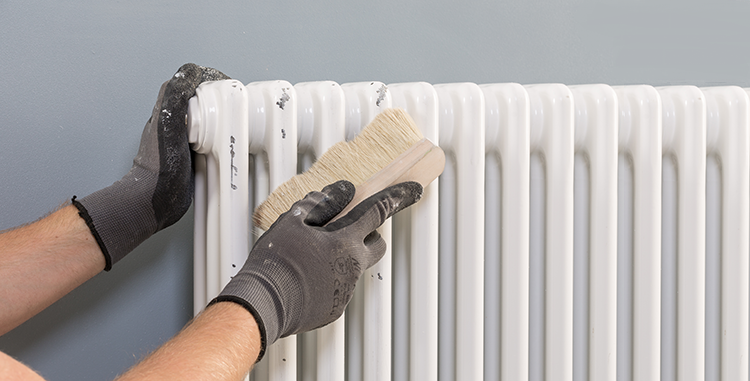
For high-quality painting, it is necessary to clean the surface of the radiator, remove dust and particles of the old coating
Advice! There are many types of primers that differ in different parameters. The most suitable choice for painting a heater is an alkyd-based primer.
After all the stages of preparation are completed, you can proceed directly to painting:
- First of all, you need to cover the floor under the radiator with old newspapers or any other unnecessary material to avoid paint getting on it.
- It is necessary to pick up two brushes and prepare protective gloves. The brushes should be with soft bristles, and one of them should be normal, and the other should be curved (to paint hard-to-reach spots). It is also worth remembering one rule - paint is applied from the top of the battery to the bottom.First paint the internal ceilings, and then everything else to avoid contamination of hands and clothes.
- After one coat is applied, it is necessary to wait until the paint hardens and re-paint.
You can color the batteries with any type of paint, the main thing is to choose heat-resistant compositions and adhere to the technology of their application.
